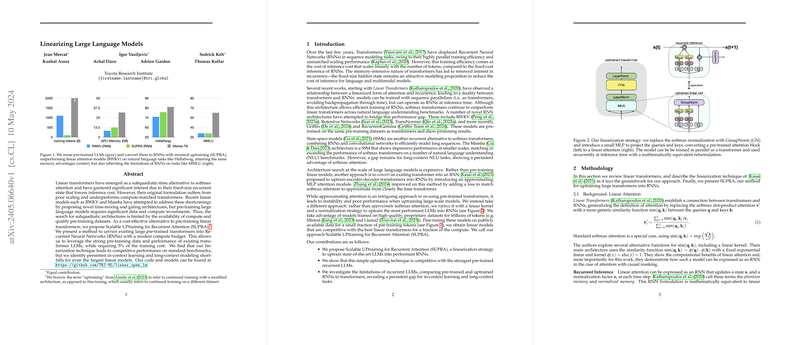Understanding SUPRA: A New Approach to Linearize Pre-trained Transformers into RNNs
Overview of the Proposed Method
The freshly introduced method called Scalable UPtraining for Recurrent Attention (SUPRA) seeks a cost-effective way to transform pre-trained transformers into Recurrent Neural Networks (RNNs). This approach could potentially leverage the strengths of both architectures — the powerful pre-training of transformers and the cost-efficient inference capabilities of RNNs.
The Challenge with Linear Transformers
Conventional transformers excel due to their parallelizable nature, which provides high efficiency in training over long sequences. However, they suffer from high inference costs relative to RNNs, which maintain a fixed-size hidden state and are, as a result, generally more memory-efficient.
Despite the introduction of linear transformers as a subtype that aims to replicate the trainable advantages of the transformer while catering to memory efficiency, they typically fall short of conventional transformers on intensive Natural Language Processing benchmarks.
Enter SUPRA: A Hybrid Training Approach
SUPRA introduces a middle ground by uptraining - a process of continuing training with a modified architecture. This method begins with a well-established pre-trained transformer and subtly adjusts it to imitate an RNN during inference time.
The Process
- Linearization Technique: Replace the softmax normalization commonly found in transformers with GroupNorm, a type of normalization that can help balance the output across different nodes in a network.
- Positional Encoding Adjustment: Integrate a rotary positional encoding scheme to cater to disturbances often encountered with absolute positional encoding in RNNs.
SUPRA cleverly addresses an issue inherent to other linear approaches by utilizing only a small fraction of the original training tokens for uptraining. This ensures cost-effectiveness while maintaining competitive model performance.
Testing the Performance
The uptrained models were rigorously evaluated across several benchmarks:
- Standard Language Benchmarks: SUPRA models displayed competitive performance against leading pretrained recurrent models using notably less data and compute resources.
- Long-Context Tasks: Despite their promise, the linearized models under SUPRA showed limitations in tasks requiring extended context, underscoring a gap that still exists with conventional transformers.
The Implications and Future Prospects
The birth of SUPRA shifts the landscape for how large-scale models could be transformed to achieve efficiency without an enormous compute overhead. Practically, this could make RNNs viable again for applications where inference cost and resource efficiency are critical.
On the Theoretical Side
SUPRA shows that there's a rich vein to explore in the hybrid modeling approach, potentially setting the stage for future research focusing on optimizing these hybrid architectures.
Looking Forward
While SUPRA demonstrates a promising approach, the models' struggle with long-context tasks suggests a need for further tweaking. Innovations such as more complex gating mechanisms and alternative normalization techniques could potentially bridge the observed performance gap.
Conclusion
SUPRA presents an intriguing prospect in the quest for efficient AI modeling, offering a new toolkit for those looking to harness the strengths of transformers and RNNs alike. With continued development, SUPRA or its derivatives might soon become a staple in reducing computational costs while sustaining high performance across a range of AI tasks.
